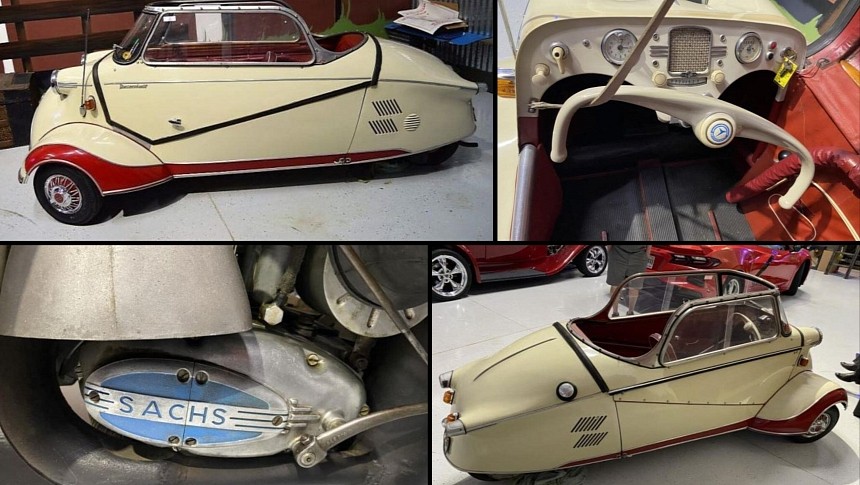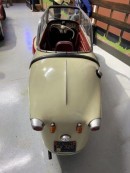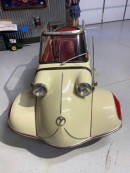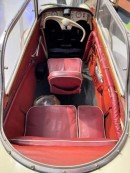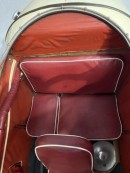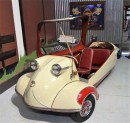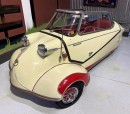Born in the years following World War II as an alternative to motorcycles, microcars remained popular until the 1960s thanks to their low fuel consumption and affordable price and maintenance. The BMW Isetta is perhaps the most iconic, but Germany was packed with microcar manufacturers at the time.
Heinkel and Messerschmitt, which produced aircraft during World War II, also joined the microcar market in the 1950s, mainly because they were not allowed to return to aircraft manufacturing for ten years. Heinkel switched to bicycles and scooters before introducing the Kabine in 1956. Messerschmitt jumped on the microcar bandwagon in 1953 with the KR175.
But unlike other microcar builders, Messerschmitt did not adopt the popular bubble design. Instead, the German company remained true to its roots and opted for an aircraft-inspired layout.
Built for three years, the KR175 had a canopy-like roof, offered seating for two, and relied on a 173cc, two-stroke, single-cylinder engine for power. Rated at nine horsepower, the Fichtel & Sachs mill enabled the KR175 to hit a top speed of 50 mph (80 kph) while returning up to 64 mpg.
In 1955, Messerschmitt introduced an updated version called the KR200. Although it resembled its predecessor, the KR200 arrived with a reworked suspension setup, hydraulic shock absorbers at all three wheels, and an improved interior design.
The new 191cc two-stroke engine delivered ten horsepower and propelled the 230-kg (507-pound) microcar to a 56-mph (90-kph) top speed. A specially-prepped version ran for 24 hours at the Hockenheimring, setting 22 speed records for three-wheeled vehicles under 250cc. The KR200 was an instant hit when it arrived in showrooms, moving 12,000 units in its first year. Sales eventually slowed down, and Messerschmitt ended production in 1964 with 41,190 examples made.
Far from being a very desirable classic, the KR200 enjoys a cult following among microcar enthusiasts, and it's a cool piece of automotive and even aircraft-related history. And that's precisely why I got excited when I stumbled upon a low-mileage example that looks like it had just left the Messerschmitt factory.
And I'm not talking about a car that's been driven for 30,000 to 50,000 miles (48,280 to 80,467 km) or so. This thing is an authentic time capsule with an odometer showing only 683 miles (1,099 km). Needless to say, it looks pristine inside and out, and it runs and drives like new. It also comes with all the original paperwork, yet another rare feat for a 70-year-old vehicle.
Surprisingly enough, this Messerschmitt is spending its retirement ears in Newburgh, Indiana. I have no idea how many KR200s made it on this side of the pond, but we're probably looking at only a few examples since American drivers were busy buying increasingly larger and more powerful cars in the 1950s. The auction sits at $10,500 with 17 days to go, and it will be interesting to see how much it goes for when the gavel drops.
But unlike other microcar builders, Messerschmitt did not adopt the popular bubble design. Instead, the German company remained true to its roots and opted for an aircraft-inspired layout.
Built for three years, the KR175 had a canopy-like roof, offered seating for two, and relied on a 173cc, two-stroke, single-cylinder engine for power. Rated at nine horsepower, the Fichtel & Sachs mill enabled the KR175 to hit a top speed of 50 mph (80 kph) while returning up to 64 mpg.
In 1955, Messerschmitt introduced an updated version called the KR200. Although it resembled its predecessor, the KR200 arrived with a reworked suspension setup, hydraulic shock absorbers at all three wheels, and an improved interior design.
The new 191cc two-stroke engine delivered ten horsepower and propelled the 230-kg (507-pound) microcar to a 56-mph (90-kph) top speed. A specially-prepped version ran for 24 hours at the Hockenheimring, setting 22 speed records for three-wheeled vehicles under 250cc. The KR200 was an instant hit when it arrived in showrooms, moving 12,000 units in its first year. Sales eventually slowed down, and Messerschmitt ended production in 1964 with 41,190 examples made.
Far from being a very desirable classic, the KR200 enjoys a cult following among microcar enthusiasts, and it's a cool piece of automotive and even aircraft-related history. And that's precisely why I got excited when I stumbled upon a low-mileage example that looks like it had just left the Messerschmitt factory.
And I'm not talking about a car that's been driven for 30,000 to 50,000 miles (48,280 to 80,467 km) or so. This thing is an authentic time capsule with an odometer showing only 683 miles (1,099 km). Needless to say, it looks pristine inside and out, and it runs and drives like new. It also comes with all the original paperwork, yet another rare feat for a 70-year-old vehicle.
Surprisingly enough, this Messerschmitt is spending its retirement ears in Newburgh, Indiana. I have no idea how many KR200s made it on this side of the pond, but we're probably looking at only a few examples since American drivers were busy buying increasingly larger and more powerful cars in the 1950s. The auction sits at $10,500 with 17 days to go, and it will be interesting to see how much it goes for when the gavel drops.
